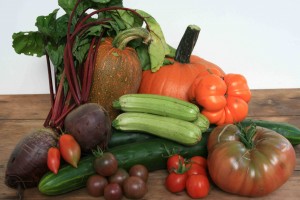 Golden sunlight casts long shadows on the grass, spider’s webs carpet the fields in the morning mist, skeins of calling geese fill the sky: it’s autumn again. Harvest is all around us. Combines roll across the golden fields, the hedgerows are weighed down with fruit: blackberries, sloes, wild plums. As the apple trees begin to throw their bounty to the ground I struggle to keep up with the abundance in the veg garden. Everywhere nature is sending out early signals urging us to prepare for winter. Our lives on the farm are so wedded to the seasons, spring lambing, summer growth, autumn harvest, the austerity of winter. I try to imagine the urban oblivion to the changing landscape, the uniformity of street and pavement across the year, the ready food, always the same, always available regardless of season in the supermarket: a security that is not for me.
Golden sunlight casts long shadows on the grass, spider’s webs carpet the fields in the morning mist, skeins of calling geese fill the sky: it’s autumn again. Harvest is all around us. Combines roll across the golden fields, the hedgerows are weighed down with fruit: blackberries, sloes, wild plums. As the apple trees begin to throw their bounty to the ground I struggle to keep up with the abundance in the veg garden. Everywhere nature is sending out early signals urging us to prepare for winter. Our lives on the farm are so wedded to the seasons, spring lambing, summer growth, autumn harvest, the austerity of winter. I try to imagine the urban oblivion to the changing landscape, the uniformity of street and pavement across the year, the ready food, always the same, always available regardless of season in the supermarket: a security that is not for me.

The house martins have already left. Flying practice started early this year. At the end of August juniors were already lining up on the telegraph wires for flying tuition from their swooping elders. Sam raced across the top fields pursuing them as they skimmed the long grass for insects, he’s much to slow for them and they continue to feed oblivious to his game. He joined us at the end of June, a rangy skinny chap, another boy from Labrador Rescue.

For six weeks, after the demise of dear old Welly, Porter mooched around looking miserable, us too. Finally I picked up the phone and two days later an eleven month old Sam, his new name, was with us. Porter was thrilled and we were soon exhausted! I began to wonder why my friends do work outs in the gym; no need for me with Sammy by my side. In the first week he was blissed out by falling in the pond not once but twice. I’m sure the second time was deliberate as he swam happily amongst the water lilies.

Next he rolled down the bank into the stream, somersaulted and, turning “turbo-dog”, raced up and down splashing in utter delight. Labradors adore water, it’s true. He thought the chickens were worth a chase, got stuck in the undergrowth in the quarry, was given a very severe ticking off by the cats, showed a little too much interest in the sheep and made a friend of a donkey who generally doesn’t care for dogs at all.
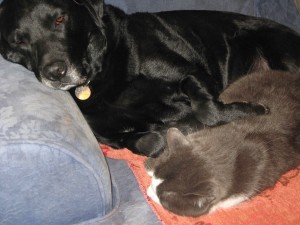
Sammy is a very different boy to Mr P with a very different story. Both dogs came from social housing backgrounds, lots of kids and a struggling single mum. That’s where the similarity ends. Mr P had been kept in a cage neglected and starved; Sam was allowed to run wild with no boundaries at all, until his owner’s partner, irritated by him, hit him regularly: all this on his rescue notes. A very different approach was needed to help him settle down and feel safe with us. Beneath the delinquent teenager is a sweet gentle dog, wonderful with children. Our grandchildren’s long summer holiday with us was invaluable. He played with them, socialised with their dogs, learnt that cats and chickens are best ignored and Guinea pigs are simply boring. The transformation had begun. But we soon realised it was us who needed more training if he was to become a really happy dog. So it was off to Cumbria for Paul for doggy boot camp! Not really, it all turned out wonderfully for them both: two nights in a lovely dog friendly pub and expert training by a wonderful professional in the dramatically beautiful Lake District. Oh, it’s so simple when you know how!! Everyday Sammy has his doggy Tutorial and the transformation is a joy to watch as he settles into his new life, loved and safe at last.
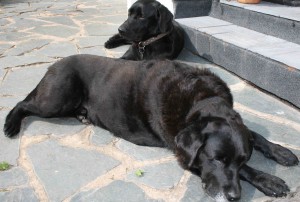
Maybe it’s to do with his past life or maybe it’s just because he’s a Labrador, Sam is an expert harvester. First it was the Dit’sum plums, then blackberries, figs, apples. And now he’s discovered the tomatoes; not an ideal arrangement for either of us! I have a glut this year despite the sodden winter and return of the tomato blight. Every year a dear friend sources wonderful heritage seeds for me. I grow enough for both of us and when she returns from a warm winter the other side of the world we share the seedlings.
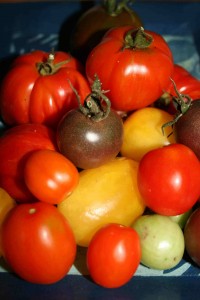
This year I grew Yellow Brandywine, Black Cherry, and the amazing giants, Cherokee, as well as modern Pomodoro Red Cherry and funny pointed Follia F1. Last year saw success with Striped Cavern, Ivory Egg, Copia and Japanese Black Trifele. Of course I’ve grown good old gardeners Delight and Moneymaker too but the heritage ones are such fun and more of a challenge. The flavour is often better too. For years solanum lycopersicum were considered poisonous in this country. Gerard dismisses them out of hand in his Herbal of 1597: “Poma Amoris, Apples of Love. …In Spaine and those hot Regions they vse to eat the Apples prepared and boiled with pepper, salt, and oile: but they yeeld very little nourishment to the bodie, and the same nought and corrupt. Likewise they doe eat the Apples with oile, vineger and pepper mixed together for sauce to their meate, euen as we in these cold Countries doe Mustard.”. They were already being eaten in Italy and Spain by then, brought back from the Andes by the Spanish Conquistadors. Tomato comes from “tomatl” in Nahuatl, the language of the Aztecs. The Italians called it Pomma di Mori, Apple of the Moors. The first reference to the cooking of tomatoes in Italy can be found in Vincenzo Corrado’s 1765 Cuoco Galante, The Gallant Cook. In his wonderful book, Complete Italian Food, Antonio Carluccio states that Italians now consume an astonishing 50kg per head per year mostly in the form of sauce and purees on their pasta! In France it was named Pomme d’Amour and in time embraced as warmly as in Spain and Italy. In contrast we cautious Brits only began to let the Love Apple creep into our diet around 1820 still clinging to the dire warnings of Gerard two hundred years earlier and despite the best efforts of the Quaker merchant, Peter Collinson who reported in 1742 that the Apples of Love “are very much in Italy to putt when ripe into their Brooths & Soops giving it a pretty Tart Taste. A Lady Just come from Leghorn says she thinks it gives an Agreeable tartness and Relish to them & she likes it Much”. Tomatoes were considered as “chill to the stomach”, the cause of maladies such as gout and a dangerous aphrodisiac. How times have changed!
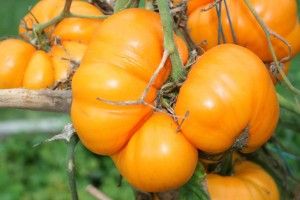
So What to do with all this deliciousness? I will be halving the small red tomatoes and putting them in a cool oven overnight to semi dry them. Then I will bottle them in olive oil with a sprig of basil and store them in the fridge for winter treats: a tiny salad with grated Parmesan, a quick pasta topping or a filling for a baked potato.
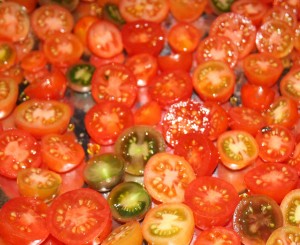
One of my favourite recipes takes me back to a tiny village in the hills in Provence many years ago when Madam cooked just one set meal in her tiny restaurant in the Village Square: no choice and the food served in big dishes straight to the table. I can’t remember the rest of the meal only the exquisite beans and tomatoes! Blanche French beans, drain carefully and return to the pan with olive oil. Add a clove of crushed garlic and fresh chopped tomatoes. Simmer gently for a few minutes. Add salt and pepper and serve with more really good olive oil. That’s it, truly wonderful if the beans are tender, the tomatoes full of flavour and the olive oil thick and green.
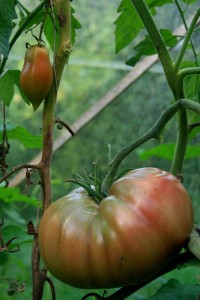
The big boys such as Cherokee will be a meal in themselves. I will scoop out their middles, make a stuffing, top them with breadcrumbs and cheese and bake them in the oven. Others will be made into sauce with shallots, herbs and garlic, then frozen ready to go into winter ragouts and pasta sauces. Some I will simply whizz in the blender and freeze. And, of course, the green tomatoes will join apples, sugar, shallots, chili, and vinegar to become thick unctuous chutney. None will be wasted so long as I keep Sam out of the greenhouse!

Leave a Reply